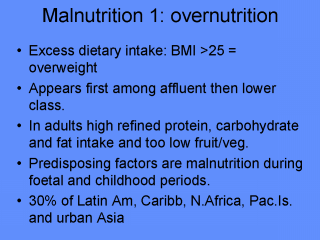| front |1 |2 |3 |4 |5 |6 |7 |8 |9 |10 |11 |12 |13 |14 |15 |16 |17 |18 |19 |20 |21 |review |
 |
Nutritional
disorders are widespread, and may be more common in highly developed industrialized
nations that poorer agrarian economies. While the latter may be more vulnerable to
periodic and extreme swings in food availability, the former are more or less constantly
over-provided with excess food intake. However, much of this may be inappropriate, and in
a form which has low nutritional value, such as high calorifically-dense refined sugars
and fats while being depleted in essential micro-nutrients, or more obviously fresh
vegetables and fruits. Over-nutrition is seen among people who have a Adults in HK tend to have excessive consumption of animal protein, refined carbohydrates and fats relative to intake of vegetables, grains and fruits. Coupled with a decrease in activity, this results in a growing problem with obesity. This kind of excess malnutrition currently affects about one person in three in Latin America, the Caribbean, North Africa, the Pacific Islands and urban Asia. |
| front |1 |2 |3 |4 |5 |6 |7 |8 |9 |10 |11 |12 |13 |14 |15 |16 |17 |18 |19 |20 |21 |review |